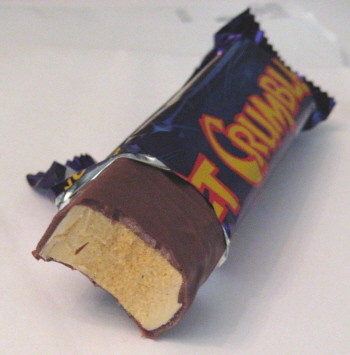
I am a glutton, a gourmande, a golosa. In any language, the fact is, I love sweets and will not pass up an opportunity to eat sugar spun into a fancy confection. When I traveled with my parents to Lyon in 2002 or 2003, we discovered the city's historical sweet: the coussin de Lyon (or pillow of Lyon). This marvelous treat does look like a miniature pillow fit for royalty. The center is a rich ganache with a splash of curaçao or other liqueur (the recipe for the coussin is under lock and key, and noone except the confectionery who produces it know the exact recipe. There are coussin knock-offs as well, and I don't think their recipes are well-known either.). The ganache is surrounded by a layer of almond paste that is finely candied on the top. The pillow is distinguished with its pale aqua-green color and a fine stripe of darker green running down the length. It's an intense bite. It'll cost you, too. I figure that with the dollar so low right now, I'll end up paying more than three dollars per square inch coussin (when I go to France and hunt down a bag of these later in May). But those are the lengths I like to go to for sweets.
According to Wikipedia (and my loose translation), in 1643, the mayors of Lyon decided to plead to the Virgin Mary to spare the town from the plague epidemic. In so doing, they lit a 7 pound wax candle and put a gold piece on a silk pillow (is it just me, or does something here not make sense?). Jump forward over 300 years to 1960, where the Lyonnais chocolatier Voisin decided to make a candy in the shape of very same pillow. Well, that's one theory, anyway.
The exterior is hard, with its crystallized sugar coating. Take a bite and the candy softens into ganache, with the flavors of almond, orange, and chocolate coming through.
I ran out of my last bag of these candies shortly following a trip to Nice in 2006, where I've actually found some of the best coussins de Lyon. It's been over two years, and with the European trip looming, I'm looking forward to more of them, at any cost, as I mentioned. But there's a blip in my waiting period for coussins. Last weekend I went to the Fillmore Street's Patisserie Delanghe, a French bakery that is less well-known than the neighboring French rival/giant Bay Bread/Boulangerie. (The pastries looked less glamorous at Delanghe, the croissants forming a less-than-perfect crescent, providing less reason to spend $2.75 for just one.) But then I turned to the second pastry case where the fancy cakes and pastry puffs with hardened caramel sit. Underneath those I saw a platter of the little chocolate logs, one of which is pictured above. As far as I know, these have no official name. The cashier called them marzipans, which they are. But they're more, and they're perhaps the closest thing I've tasted to a coussin lyonnais.
One of these rouleaux (rolls, as I've taken to calling them) was not enough for me, so I went back the next day for another. This time, M Delanghe was working alone. He didn't notice me when I entered the shop, and was in fact reading a magazine. Lazy Sunday! I took a minute to admire the French authenticity of it all--the patissier relaxing, paying no notice to a customer. Who am I to trouble him, after all? Finally, he took his notice of me and walked over to greet me with a pleasant smile.
"Could I get two of those--those rouleaux?" I stammered, eager to impress with my French accent.
He gazed over the countertop at the other pastry case to see what I was talking about, but I was met only with his blank stare.
"Those rouleaux, the little logs." Silence. "The marzipan." I finally said, remembering the cashier's name for them. "They remind me of the coussins de Lyon," I went on, trying to get something out of him, a sign of recognition, or acknowledgment that I was in on the secret--he was creating his own version of the coussins. How many people know about the coussins outside of France? I thought. I've even met French people who don't know what they are. I was futilely looking for a connection to this French baker.
"Ah, they remind you of the coussins de Lyon," he repeated with a playful smile, and pulled two of the freshest looking marzipans off the plate and put them into a pastry bag for me.
"Three-Ninety." He asked for the cash.
That's $1.95 each, much less than the actual coussin will cost me in France, and twice its size. I didn't figure out what the patissier meant that day, if he knew what the coussins are (I am fairly certain that he did, if he's an expert in his craft) or if he thought I was trying to say something in French but had no clue. "She thinks my candy tastes like the pillows in Lyon?! Stupid girl!" Perhaps he thought the less of me. But I don't care. I'll go back again for these--probably a couple of times--before my trip to France.
Actual coussins de Lyon in a fancy "pillow" case.
















 Lemon curd:
Lemon curd:
































